KIA Spectra 2006 2.G Service Manual
Manufacturer: KIA, Model Year: 2006, Model line: Spectra, Model: KIA Spectra 2006 2.GPages: 273, PDF Size: 2.83 MB
Page 41 of 273
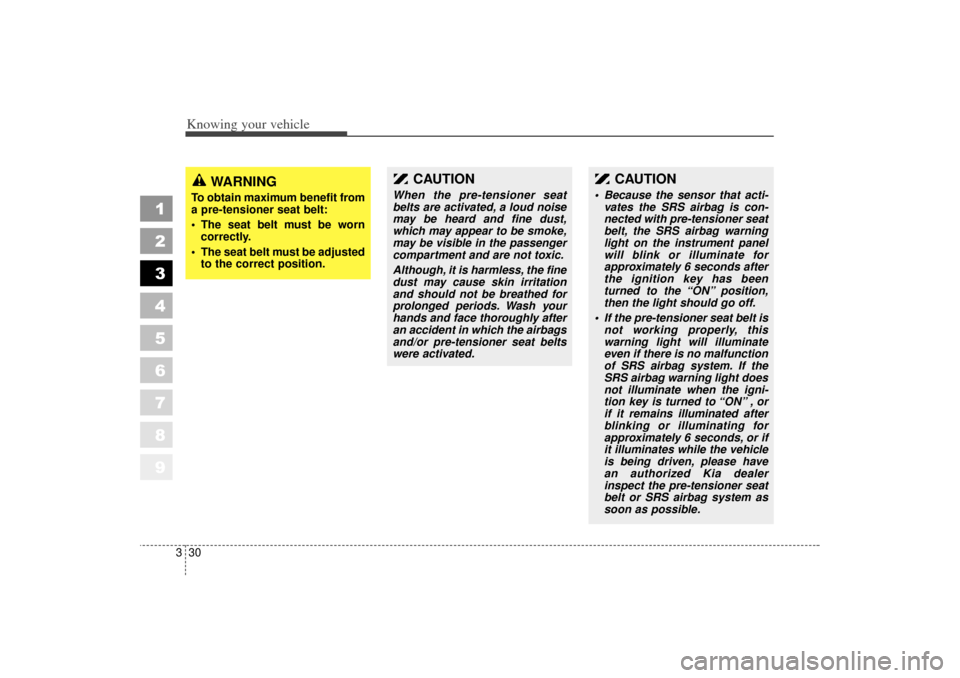
Knowing your vehicle30
3
1
2
3
4
5
6
7
8
9
WARNING
To obtain maximum benefit from
a pre-tensioner seat belt:
The seat belt must be worn
correctly.
The seat belt must be adjusted to the correct position.
CAUTION
When the pre-tensioner seat
belts are activated, a loud noise
may be heard and fine dust,
which may appear to be smoke,
may be visible in the passenger
compartment and are not toxic.
Although, it is harmless, the fine
dust may cause skin irritation
and should not be breathed for
prolonged periods. Wash your
hands and face thoroughly after
an accident in which the airbags
and/or pre-tensioner seat belts
were activated.
CAUTION
Because the sensor that acti-vates the SRS airbag is con-
nected with pre-tensioner seat
belt, the SRS airbag warning
light on the instrument panel
will blink or illuminate for
approximately 6 seconds after
the ignition key has been
turned to the “ON” position,
then the light should go off.
If the pre-tensioner seat belt is not working properly, this
warning light will illuminate
even if there is no malfunction
of SRS airbag system. If the
SRS airbag warning light does
not illuminate when the igni-
tion key is turned to “ON” , or
if it remains illuminated after
blinking or illuminating for
approximately 6 seconds, or if
it illuminates while the vehicle
is being driven, please have
an authorized Kia dealer
inspect the pre-tensioner seat
belt or SRS airbag system as
soon as possible.
LD CAN (ENG) new 3-1~.qxd 7/29/05 10:28 AM Page 30
Page 42 of 273
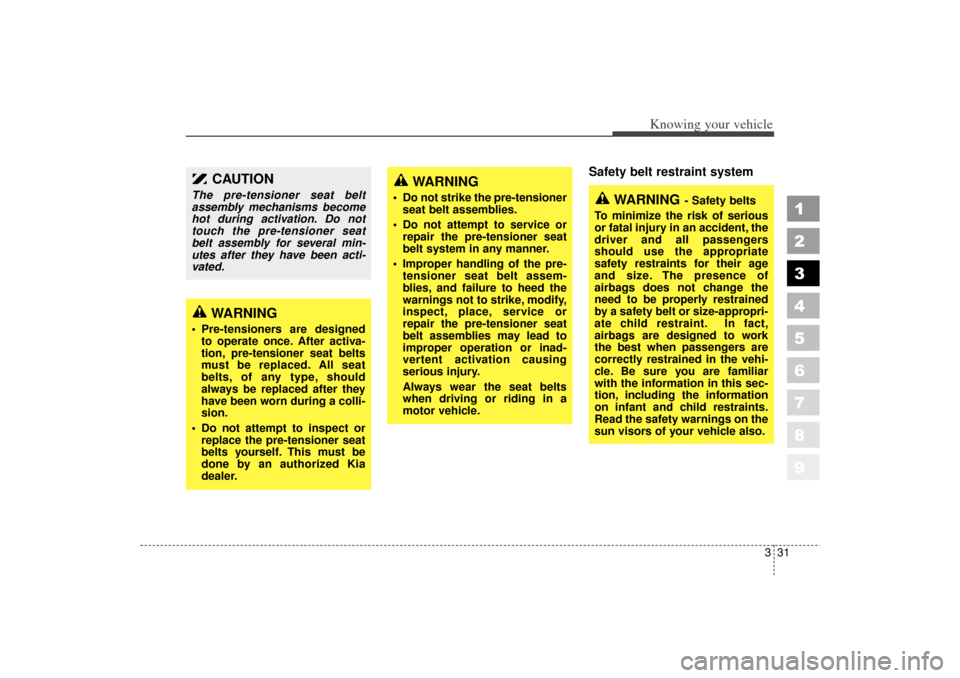
331
1
2
3
4
5
6
7
8
9
Knowing your vehicle
Safety belt restraint system
WARNING
Pre-tensioners are designedto operate once. After activa-
tion, pre-tensioner seat belts
must be replaced. All seat
belts, of any type, should
always be replaced after they
have been worn during a colli-
sion.
Do not attempt to inspect or replace the pre-tensioner seat
belts yourself. This must be
done by an authorized Kia
dealer.
CAUTION
The pre-tensioner seat belt
assembly mechanisms become
hot during activation. Do not
touch the pre-tensioner seat
belt assembly for several min-
utes after they have been acti-
vated.
WARNING
Do not strike the pre-tensionerseat belt assemblies.
Do not attempt to service or repair the pre-tensioner seat
belt system in any manner.
Improper handling of the pre- tensioner seat belt assem-
blies, and failure to heed the
warnings not to strike, modify,
inspect, place, service or
repair the pre-tensioner seat
belt assemblies may lead to
improper operation or inad-
vertent activation causing
serious injury.
Always wear the seat belts
when driving or riding in a
motor vehicle.
WARNING
- Safety belts
To minimize the risk of serious
or fatal injury in an accident, the
driver and all passengers
should use the appropriate
safety restraints for their age
and size. The presence of
airbags does not change the
need to be properly restrained
by a safety belt or size-appropri-
ate child restraint. In fact,
airbags are designed to work
the best when passengers are
correctly restrained in the vehi-
cle. Be sure you are familiar
with the information in this sec-
tion, including the information
on infant and child restraints.
Read the safety warnings on the
sun visors of your vehicle also.
LD CAN (ENG) new 3-1~.qxd 7/29/05 10:28 AM Page 31
Page 43 of 273
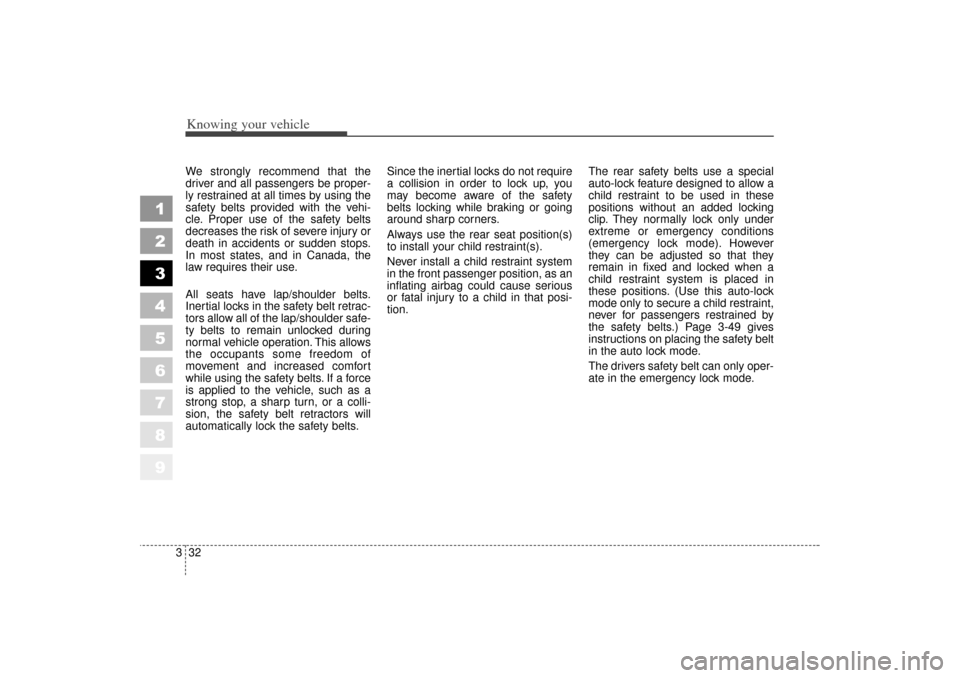
Knowing your vehicle32
3
1
2
3
4
5
6
7
8
9
We strongly recommend that the
driver and all passengers be proper-
ly restrained at all times by using the
safety belts provided with the vehi-
cle. Proper use of the safety belts
decreases the risk of severe injury or
death in accidents or sudden stops.
In most states, and in Canada, the
law requires their use.
All seats have lap/shoulder belts.
Inertial locks in the safety belt retrac-
tors allow all of the lap/shoulder safe-
ty belts to remain unlocked during
normal vehicle operation. This allows
the occupants some freedom of
movement and increased comfort
while using the safety belts. If a force
is applied to the vehicle, such as a
strong stop, a sharp turn, or a colli-
sion, the safety belt retractors will
automatically lock the safety belts. Since the inertial locks do not require
a collision in order to lock up, you
may become aware of the safety
belts locking while braking or going
around sharp corners.
Always use the rear seat position(s)
to install your child restraint(s).
Never install a child restraint system
in the front passenger position, as an
inflating airbag could cause serious
or fatal injury to a child in that posi-
tion.
The rear safety belts use a special
auto-lock feature designed to allow a
child restraint to be used in these
positions without an added locking
clip. They normally lock only under
extreme or emergency conditions
(emergency lock mode). However
they can be adjusted so that they
remain in fixed and locked when a
child restraint system is placed in
these positions. (Use this auto-lock
mode only to secure a child restraint,
never for passengers restrained by
the safety belts.) Page 3-49 gives
instructions on placing the safety belt
in the auto lock mode.
The drivers safety belt can only oper-
ate in the emergency lock mode.
LD CAN (ENG) new 3-1~.qxd 7/29/05 10:28 AM Page 32
Page 44 of 273
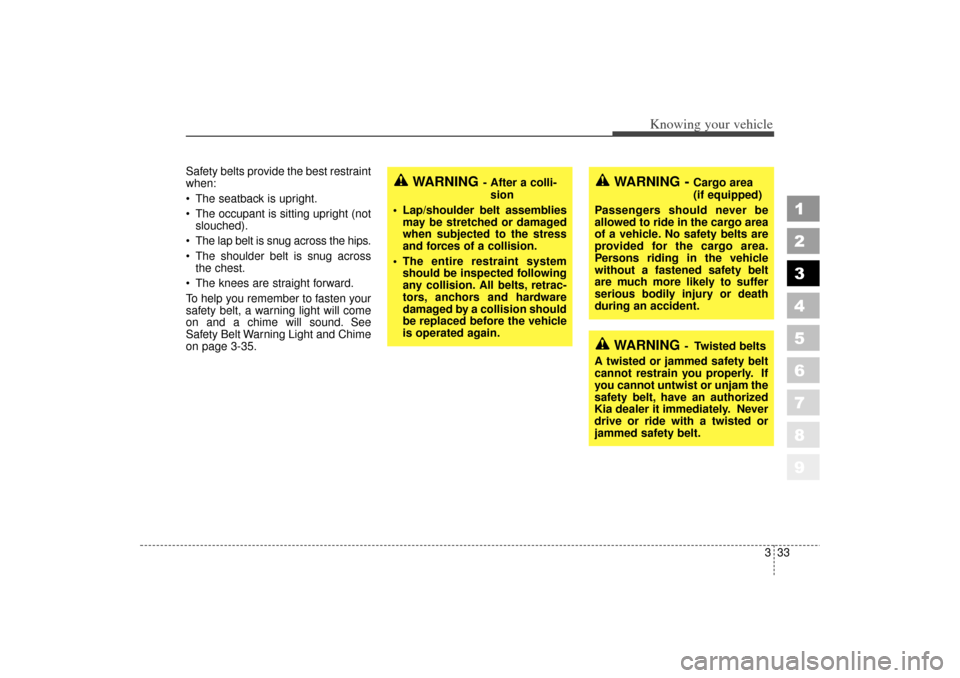
333
1
2
3
4
5
6
7
8
9
Knowing your vehicle
Safety belts provide the best restraint
when:
The seatback is upright.
The occupant is sitting upright (notslouched).
The lap belt is snug across the hips.
The shoulder belt is snug across the chest.
The knees are straight forward.
To help you remember to fasten your
safety belt, a warning light will come
on and a chime will sound. See
Safety Belt Warning Light and Chime
on page 3-35.
WARNING
- After a colli- sion
Lap/shoulder belt assemblies may be stretched or damaged
when subjected to the stress
and forces of a collision.
The entire restraint system should be inspected following
any collision. All belts, retrac-
tors, anchors and hardware
damaged by a collision should
be replaced before the vehicle
is operated again.
WARNING -
Cargo area
(if equipped)
Passengers should never be
allowed to ride in the cargo area
of a vehicle. No safety belts are
provided for the cargo area.
Persons riding in the vehicle
without a fastened safety belt
are much more likely to suffer
serious bodily injury or death
during an accident.
WARNING
- Twisted belts
A twisted or jammed safety belt
cannot restrain you properly. If
you cannot untwist or unjam the
safety belt, have an authorized
Kia dealer it immediately. Never
drive or ride with a twisted or
jammed safety belt.
LD CAN (ENG) new 3-1~.qxd 7/29/05 10:28 AM Page 33
Page 45 of 273

Knowing your vehicle34
3
1
2
3
4
5
6
7
8
9
WARNING
- Safety belt
care
A damaged belt may not give you the protection you need in
an accident.
Inspect your safety belts peri- odically for excessive wear or
damage. Pull out each belt
fully and look for fraying, cuts,
burns or other damage. Pull
the safety belt out and let it
retract a number of times.
Make sure that the lap/shoul-
der belts return smoothly and
easily into the retractor.
Check the latches to make sure they latch and release
without interference or delay.
Never close the doors on any part of the lap or shoulder
belt.
Any belt not in good condition or in good working order
should be promptly replaced.
WARNING
- Belt use
Safety belts must be used cor-
rectly to work properly in an
accident. Each seating position
in your vehicle has a specific
safety belt assembly that
includes a buckle and tongue
designed to be used together.
For greatest effectiveness, fol-
low these guidelines in using
safety belts:
Use the shoulder portion of the safety belt on the outside
shoulder only. Never wear the
shoulder portion under the
arm.
Never swing the safety belt around your neck to fit over
the inside shoulder.
Never wear the shoulder por- tion of the safety belt across
the neck or face.
(Continued)
(Continued)
Wear the lap portion as low aspossible. Be sure that the lap
belt fits snugly around the
hips. Never wear a lap portion
of a lap/shoulder belt over
your waist; it should always
go over the stronger area of
your hips.
Never use a single safety belt for more than one person.
The front seatbacks should always remain in a comfort-
able, upright position when
the vehicle is moving.
LD CAN (ENG) new 3-1~.qxd 7/29/05 10:28 AM Page 34
Page 46 of 273
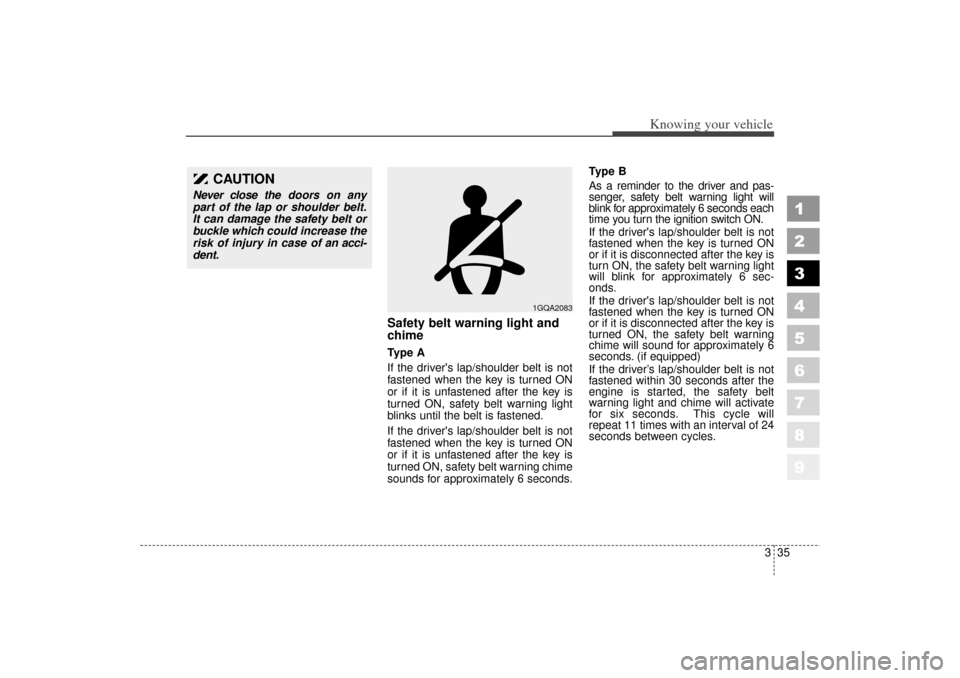
335
1
2
3
4
5
6
7
8
9
Knowing your vehicle
Safety belt warning light and
chimeType A
If the driver's lap/shoulder belt is not
fastened when the key is turned ON
or if it is unfastened after the key is
turned ON, safety belt warning light
blinks until the belt is fastened.
If the driver's lap/shoulder belt is not
fastened when the key is turned ON
or if it is unfastened after the key is
turned ON, safety belt warning chime
sounds for approximately 6 seconds.Type B
As a reminder to the driver and pas-
senger, safety belt warning light will
blink for approximately 6 seconds each
time you turn the ignition switch ON.
If the driver's lap/shoulder belt is not
fastened when the key is turned ON
or if it is disconnected after the key is
turn ON, the safety belt warning light
will blink for approximately 6 sec-
onds.
If the driver's lap/shoulder belt is not
fastened when the key is turned ON
or if it is disconnected after the key is
turned ON, the safety belt warning
chime will sound for approximately 6
seconds. (if equipped)
If the driver’s lap/shoulder belt is not
fastened within 30 seconds after the
engine is started, the safety belt
warning light and chime will activate
for six seconds. This cycle will
repeat 11 times with an interval of 24
seconds between cycles.
1GQA2083
CAUTION
Never close the
doors on any
part of the lap or shoulder belt.
It can damage the safety belt or
buckle which could increase the
risk of injury in case of an acci-
dent.
LD CAN (ENG) new 3-1~.qxd 7/29/05 10:28 AM Page 35
Page 47 of 273
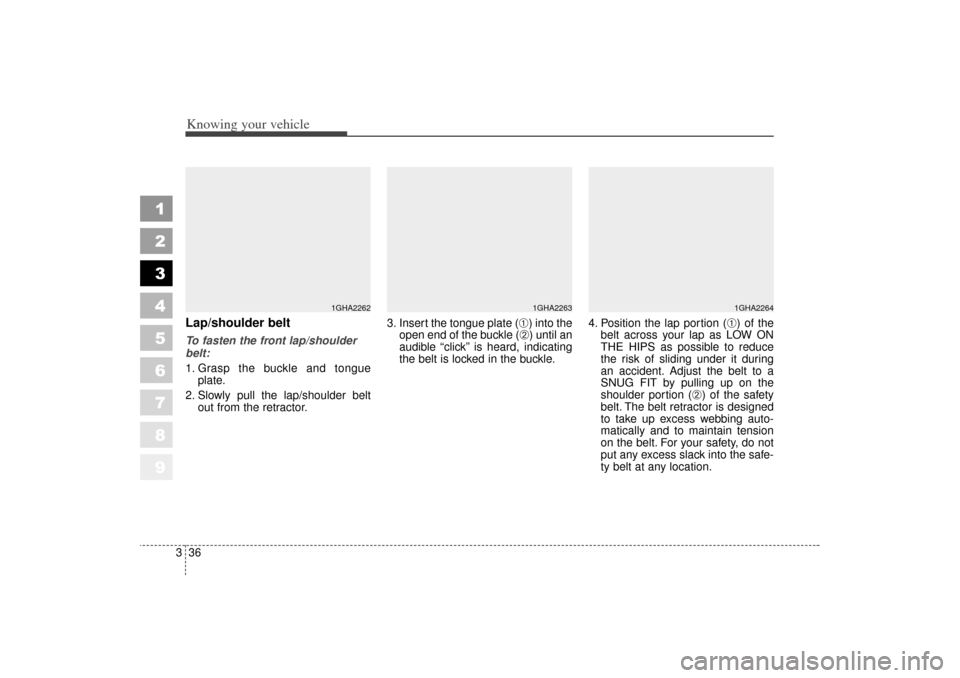
Knowing your vehicle36
3
1
2
3
4
5
6
7
8
9
Lap/shoulder beltTo fasten the front lap/shoulder
belt:
1. Grasp the buckle and tongue
plate.
2. Slowly pull the lap/shoulder belt out from the retractor. 3. Insert the tongue plate (
➀) into the
open end of the buckle (➁) until an
audible “click” is heard, indicating
the belt is locked in the buckle. 4. Position the lap portion (
➀) of the
belt across your lap as LOW ON
THE HIPS as possible to reduce
the risk of sliding under it during
an accident. Adjust the belt to a
SNUG FIT by pulling up on the
shoulder portion (
➁) of the safety
belt. The belt retractor is designed
to take up excess webbing auto-
matically and to maintain tension
on the belt. For your safety, do not
put any excess slack into the safe-
ty belt at any location.
1GHA2263
1GHA2264
1GHA2262
LD CAN (ENG) new 3-1~.qxd 7/29/05 10:28 AM Page 36
Page 48 of 273
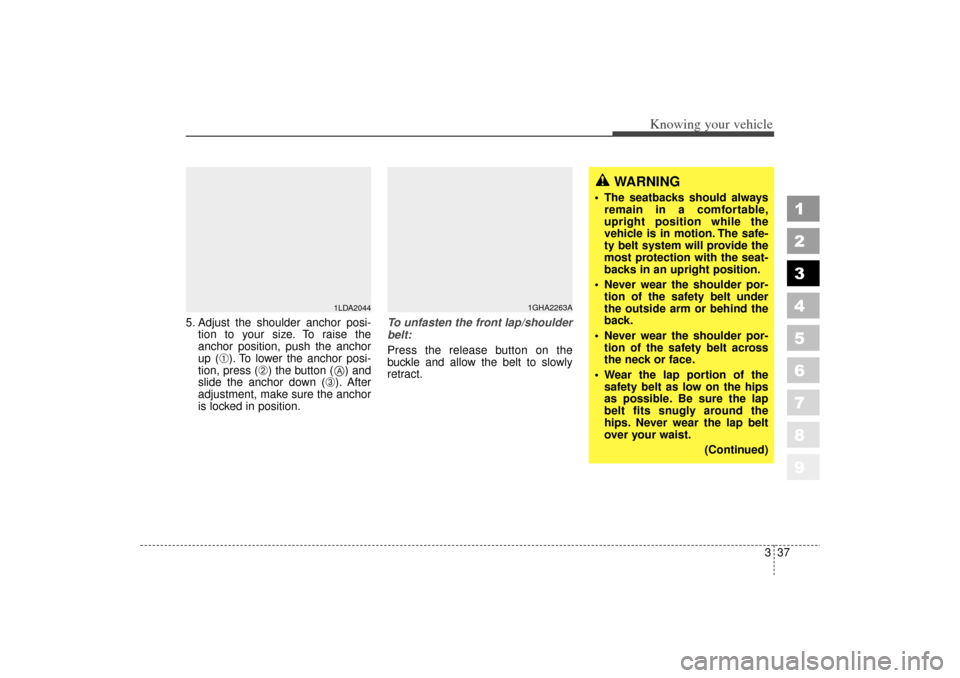
337
1
2
3
4
5
6
7
8
9
Knowing your vehicle
5. Adjust the shoulder anchor posi-tion to your size. To raise the
anchor position, push the anchor
up (
➀). To lower the anchor posi-
tion, press (
➁) the button ( ) and
slide the anchor down (
➂). After
adjustment, make sure the anchor
is locked in position. To unfasten the front lap/shoulder
belt:
Press the release button on the
buckle and allow the belt to slowly
retract.
1GHA2263A
WARNING
The seatbacks should always
remain in a comfortable,
upright position while the
vehicle is in motion. The safe-
ty belt system will provide the
most protection with the seat-
backs in an upright position.
Never wear the shoulder por- tion of the safety belt under
the outside arm or behind the
back.
Never wear the shoulder por- tion of the safety belt across
the neck or face.
Wear the lap portion of the safety belt as low on the hips
as possible. Be sure the lap
belt fits snugly around the
hips. Never wear the lap belt
over your waist.
(Continued)
1LDA2044A
LD CAN (ENG) new 3-1~.qxd 7/29/05 10:28 AM Page 37
Page 49 of 273
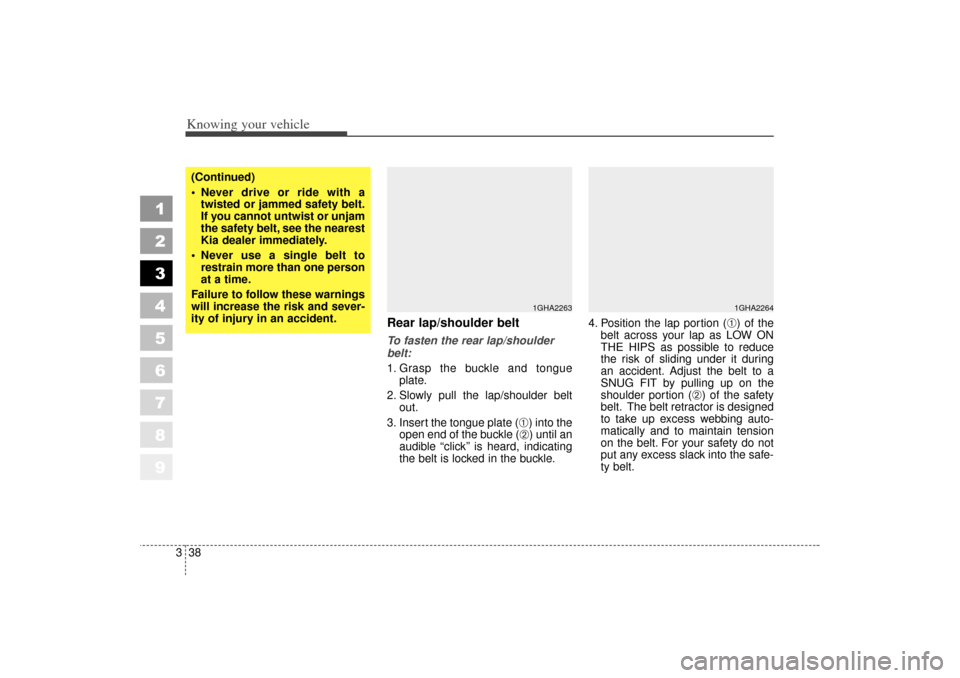
Knowing your vehicle38
3
1
2
3
4
5
6
7
8
9
Rear lap/shoulder belt To fasten the rear lap/shoulder
belt:
1. Grasp the buckle and tongue
plate.
2. Slowly pull the lap/shoulder belt out.
3. Insert the tongue plate (
➀) into the
open end of the buckle (➁) until an
audible “click’’ is heard, indicating
the belt is locked in the buckle. 4. Position the lap portion (
➀) of the
belt across your lap as LOW ON
THE HIPS as possible to reduce
the risk of sliding under it during
an accident. Adjust the belt to a
SNUG FIT by pulling up on the
shoulder portion (
➁) of the safety
belt. The belt retractor is designed
to take up excess webbing auto-
matically and to maintain tension
on the belt. For your safety do not
put any excess slack into the safe-
ty belt.
1GHA2263
1GHA2264
(Continued)
Never drive or ride with a twisted or jammed safety belt.
If you cannot untwist or unjam
the safety belt, see the nearest
Kia dealer immediately.
Never use a single belt to restrain more than one person
at a time.
Failure to follow these warnings
will increase the risk and sever-
ity of injury in an accident.
LD CAN (ENG) new 3-1~.qxd 7/29/05 10:28 AM Page 38
Page 50 of 273
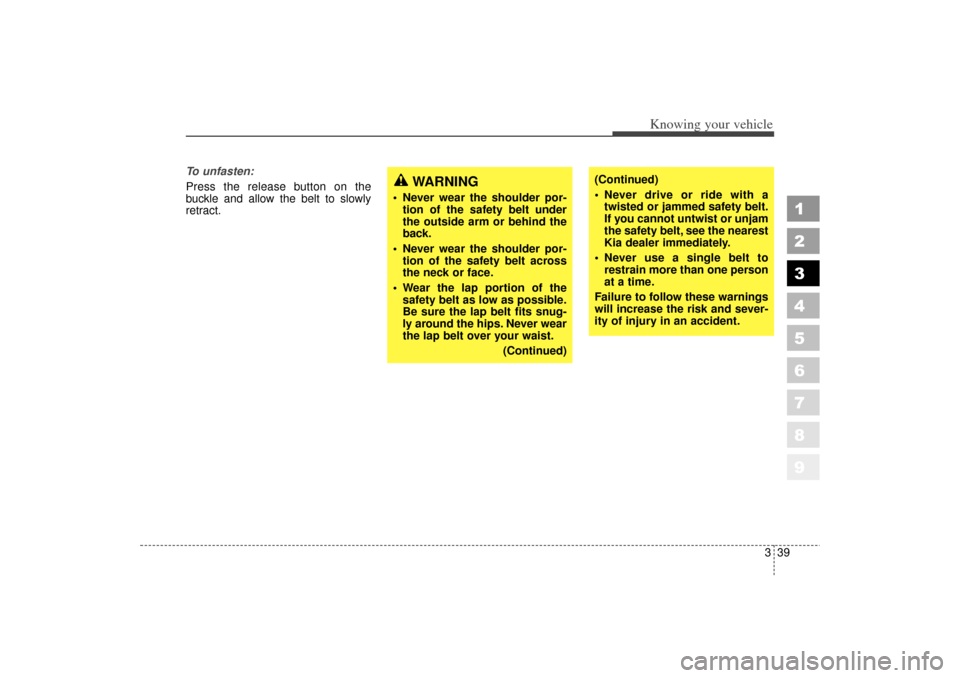
339
1
2
3
4
5
6
7
8
9
Knowing your vehicle
To unfasten:
Press the release button on the
buckle and allow the belt to slowly
retract.
(Continued)
Never drive or ride with atwisted or jammed safety belt.
If you cannot untwist or unjam
the safety belt, see the nearest
Kia dealer immediately.
Never use a single belt to restrain more than one person
at a time.
Failure to follow these warnings
will increase the risk and sever-
ity of injury in an accident.
WARNING
Never wear the shoulder por- tion of the safety belt under
the outside arm or behind the
back.
Never wear the shoulder por- tion of the safety belt across
the neck or face.
Wear the lap portion of the safety belt as low as possible.
Be sure the lap belt fits snug-
ly around the hips. Never wear
the lap belt over your waist.
(Continued)
LD CAN (ENG) new 3-1~.qxd 7/29/05 10:28 AM Page 39